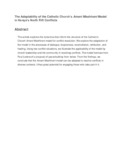| dc.contributor.author | Kilonzo, Susan Mbula | |
| dc.contributor.author | Onkware, Kennedy | |
| dc.date.accessioned | 2021-12-14T11:56:24Z | |
| dc.date.available | 2021-12-14T11:56:24Z | |
| dc.date.issued | 2021-01-27 | |
| dc.identifier.uri | https://doi.org/10.1177/2396939320985695 | |
| dc.identifier.uri | https://journals.sagepub.com/doi/abs/10.1177/2396939320985695 | |
| dc.identifier.uri | http://ir-library.mmust.ac.ke:8080/xmlui/handle/123456789/1815 | |
| dc.description.abstract | This article explores the dynamics that inform the structure of the Catholic’s Church Amani Mashinani model for conflict resolution. We explore the adaptation of the model in the processes of dialogue, forgiveness, reconciliation, retribution, and healing. Using two conflict situations, we illustrate the applicability of the model by church leadership and the community in resolving conflicts. The model borrows from Paul Lederach’s proposal of peacebuilding from below. From the findings, we conclude that the Amani Mashinani model can be adapted to resolve conflicts in diverse contexts. It has great potential for engaging those who take part in it. | en_US |
| dc.language.iso | en | en_US |
| dc.publisher | International Bulletin of Mission Research | en_US |
| dc.subject | Adaptability , Catholic, Church’s, Amani, Mashinani ,Model, Conflicts | en_US |
| dc.title | The Adaptability of the Catholic Church’s Amani Mashinani Model in Kenya’s North Rift Conflicts | en_US |
| dc.type | Article | en_US |

